Film History of the 1970s (original) (raw)
The New Decade for Film-Makers:
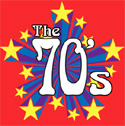 Although the 1970s opened with Hollywood experiencing a financial and artistic depression, the decade became a creative high point in the US film industry. Restrictions on language, adult content and sexuality, and violence had loosened up, and these elements became more widespread. The hippie movement, the civil rights movement, free love, the growth of rock and roll, changing gender roles and drug use certainly had an impact. And Hollywood was renewed and reborn with the earlier collapse of the studio system, and the works of many new and experimental film-makers (wrongly nicknamed "Movie Brats") during a Hollywood New Wave.
Although the 1970s opened with Hollywood experiencing a financial and artistic depression, the decade became a creative high point in the US film industry. Restrictions on language, adult content and sexuality, and violence had loosened up, and these elements became more widespread. The hippie movement, the civil rights movement, free love, the growth of rock and roll, changing gender roles and drug use certainly had an impact. And Hollywood was renewed and reborn with the earlier collapse of the studio system, and the works of many new and experimental film-makers (wrongly nicknamed "Movie Brats") during a Hollywood New Wave.
The counter-culture of the time had influenced Hollywood to be freer, to take more risks and to experiment with alternative, young film makers, as old Hollywood professionals and old-style moguls died out and a new generation of film makers arose. Many of the audiences and movie-makers of the late 60s had seen a glimpse of new possibilities, new story-telling techniques and more meaningful 'artistic' options, by the influences of various European "New Wave" movements (French and Italian) and the original works of other foreign-language film-makers.
These surprise hits in the previous decade were mostly from untested new and younger producers, directors, and actors:
- Antonioni's Blow-Up (1966)
- Penn's Bonnie and Clyde (1967)
- Nichols' The Graduate (1967)
- Boorman's Point Blank (1967)
- Lindsay Anderson's If... (1968, UK)
- Richard Lester's Petulia (1968, UK/US)
- Rafelson's Head (1968)
- Romero's Night of the Living Dead (1968)
- Kubrick's 2001: A Space Odyssey (1968)
- Schaffner's Planet of the Apes (1968)
- Penn's Alice's Restaurant (1969)
- Hopper's Easy Rider (1969)
- Haskell Wexler's Medium Cool (1969)
- Schlesinger's Midnight Cowboy (1969)
- Robert Downey Sr.'s Putney Swope (1969)
- Mazursky's Bob & Carol & Ted & Alice (1969)
- Peckinpah's The Wild Bunch (1969)
Young viewers and directors, who refused to compromise with mediocre film offerings, supported stretching the boundaries and conventional standards of film even more in this decade. Although the 50s and 60s were noted for wide-screen epics on CinemaScopic silver screens (and lighter formulaic, squeaky-clean fare such as Pillow Talk (1959) or Beach Blanket Bingo (1965)), the 70s decade was noted for films with creative and memorable subject matter that reflected the questioning spirit and truth of the times. Films that had done well in the 1960s, such as The Sound of Music (1965) would not fare well in later years with the same stars and genre, such as Star! (1968).
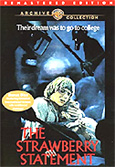 Motion picture art seemed to flourish at the same time that the defeat in the Vietnam War, the Kent State Massacre, the Watergate scandal, President Nixon's fall, the Munich Olympics shoot-out, increasing drug use, and a growing energy crisis showed tremendous disillusion, a questioning politicized spirit among the public and a lack of faith in institutions - a comment upon the lunacy of war and the dark side of the American Dream (documented, for instance, in the bicentennial year's All the President's Men (1976) or in Altman's M*A*S*H (1970)). Even Spielberg's Jaws (1975) could be interpreted as an allegory for the Watergate conspiracy.
Motion picture art seemed to flourish at the same time that the defeat in the Vietnam War, the Kent State Massacre, the Watergate scandal, President Nixon's fall, the Munich Olympics shoot-out, increasing drug use, and a growing energy crisis showed tremendous disillusion, a questioning politicized spirit among the public and a lack of faith in institutions - a comment upon the lunacy of war and the dark side of the American Dream (documented, for instance, in the bicentennial year's All the President's Men (1976) or in Altman's M*A*S*H (1970)). Even Spielberg's Jaws (1975) could be interpreted as an allegory for the Watergate conspiracy.
Other films that were backed by the studios reflected the tumultuous times, the discontent toward the government, lack of US credibility, and hints of conspiracy paranoia, such as in Alan J. Pakula's post-Watergate film The Parallax View (1974) with Warren Beatty as a muckraking investigator of a Senator's death. The Strawberry Statement (1970), derived from James S. Kunen's journal and best-selling account of the 1968 student strike at Columbia and exploited for its countercultural message of activism by MGM, echoed support of student campus protests. Although the film was expected to do well, it flopped - along with other films in a second exploitative deluge or wave of hip youth films.
Many other copy-cat or derivative films that failed with audiences (after Easy Rider's success) included:
- Richard Rush's Getting Straight (1970) about a returning Vietnam vet (Elliott Gould) attending college and mediating a campus riot
- Antonioni's American-made R-rated Zabriskie Point (1970) about youth rebellion (ending with a desert orgy)
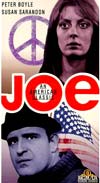 director John Avildsen's low-budget, exploitational and violent urban drama Joe (1970) that eventually grossed $20 million - with the tagline "Keep America Beautiful" presented an ugly view of countercultural life; Peter Boyle in a career-launching film starred as an enraged, intolerant, narrow-minded and bigoted blue-collar, hard-hat metal factory worker named Joe Curran; he continually felt threatened and hated all marginalized types of people: ("queers," hippies, blacks, etc.), and spouted his racist views (typical of blue-collar reactionaries in the early unsettled times of the 70s regarding the counterculture) about drug users, hippies in communes, and liberals: ("These kids s--t on ya. They s--t on your life. They s--t on everything you believe in. They s--t on everything"); the film also featured a debut role (with some nudity) for Susan Sarandon as Melissa Compton - a drug-addicted hippie flower-girl in Greenwich Village who was the daughter of a wealthy advertising executive; she OD'd on amphetamines as a result of her corruptive boyfriend Frank's drug-dealing; the loud-mouthed and brash Joe would soon become friends with Frank's murderer, Melissa's Madison Ave. executive-father Bill (Dennis Patrick), leading to a tragic freeze-framed ending (similar to the shocking massacres in the endings of Easy Rider (1969) and Bonnie and Clyde (1968) - this time murdered hippies!)
director John Avildsen's low-budget, exploitational and violent urban drama Joe (1970) that eventually grossed $20 million - with the tagline "Keep America Beautiful" presented an ugly view of countercultural life; Peter Boyle in a career-launching film starred as an enraged, intolerant, narrow-minded and bigoted blue-collar, hard-hat metal factory worker named Joe Curran; he continually felt threatened and hated all marginalized types of people: ("queers," hippies, blacks, etc.), and spouted his racist views (typical of blue-collar reactionaries in the early unsettled times of the 70s regarding the counterculture) about drug users, hippies in communes, and liberals: ("These kids s--t on ya. They s--t on your life. They s--t on everything you believe in. They s--t on everything"); the film also featured a debut role (with some nudity) for Susan Sarandon as Melissa Compton - a drug-addicted hippie flower-girl in Greenwich Village who was the daughter of a wealthy advertising executive; she OD'd on amphetamines as a result of her corruptive boyfriend Frank's drug-dealing; the loud-mouthed and brash Joe would soon become friends with Frank's murderer, Melissa's Madison Ave. executive-father Bill (Dennis Patrick), leading to a tragic freeze-framed ending (similar to the shocking massacres in the endings of Easy Rider (1969) and Bonnie and Clyde (1968) - this time murdered hippies!)- Stuart Rosenberg's unfunny comedy Move (1970) with Elliott Gould as a married New Yorker who wrote pornography
- Stanley Kramer's political drama R.P.M. (1970) (aka Revolutions Per Minute) starring Anthony Quinn as a West Coast liberal college Professor "Paco" Perez who faced campus turmoil and unrest from activist radicals when he became the university's President
- Paul Williams' socio-political drama The Revolutionary (1970), with Jon Voight headlining as the title character known only as "A" - a print-shop worker who became radicalized and violent
- writer/director Dennis Hopper's incoherent follow-up film The Last Movie (1971) - it was a tremendous embarrassment and well-publicized fiasco for Universal Studios that illustrated the dangers of giving in to auteurism
1960s social activism often turned into an inward narcissism, and yet this uncertain age still gave rise to some of the finest, boldest, and most commercially-successful films ever made (partially due to an increased experience with marketing and advertising), such as the instant Oscar-winning blockbuster The Godfather (1972) by a virtually untested director, William Friedkin's horror classic The Exorcist (1973), Spielberg's Jaws (1975) and Close Encounters of the Third Kind (1977), and Lucas' Star Wars (1977).
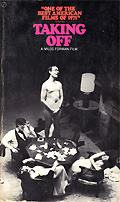 The decade also spawned equally memorable cult films, as diverse as Monte Hellman's Two-Lane Blacktop (1971) and the quirky Willy Wonka & The Chocolate Factory (1971). Jerry Schatzberg's and 20th Century Fox's raw, relentless and uncompromising The Panic in Needle Park (1971) (produced by Dominick Dunne) starkly portrayed heroin drug use among addicts in New York City, with Al Pacino in his first major acting role as a drug pusher and part of a heroin-doomed couple (opposite Kitty Winn). Czechoslovakian film-maker Milos Forman's first American film Taking Off (1971) insightfully satirized the adult middle-class and its supposed generation gap from the youth generation. There were also times when expected hits turned to disasters, however, such as the musical fantasy remake Lost Horizon (1973) and Martin Scorsese's darkly expressionistic period musical New York, New York (1977).
The decade also spawned equally memorable cult films, as diverse as Monte Hellman's Two-Lane Blacktop (1971) and the quirky Willy Wonka & The Chocolate Factory (1971). Jerry Schatzberg's and 20th Century Fox's raw, relentless and uncompromising The Panic in Needle Park (1971) (produced by Dominick Dunne) starkly portrayed heroin drug use among addicts in New York City, with Al Pacino in his first major acting role as a drug pusher and part of a heroin-doomed couple (opposite Kitty Winn). Czechoslovakian film-maker Milos Forman's first American film Taking Off (1971) insightfully satirized the adult middle-class and its supposed generation gap from the youth generation. There were also times when expected hits turned to disasters, however, such as the musical fantasy remake Lost Horizon (1973) and Martin Scorsese's darkly expressionistic period musical New York, New York (1977).
There was a remarkable diversity of themes in the films of the 70s ranging all the way from youth countercultural films, to right-wing crime films (praising vigilantism), to blaxploitation films, anti-war films (and black comedies), feminist and women's liberation films, kung-fu (and martial arts) action films, and everything in-between. The film industry reflected the rampant social change and controversies raging in the country (including but not limited to gay rights, civil rights, women's rights, the environment, and the youth-hippie movement, etc.)
The First Satellite-Delivered National Cable TV Network, 1972-75
The growth of cable TV was regarded as a serious threat to advertiser-supported broadcast television networks, independent stations, and movie theaters. These older institutions were protected by Federal Communications Commission rulings that restricted cable systems from importing distant television signals. After cable deregulation in the early '70s, one of the earliest subscription-based cable networks was The Green Channel. After Time Inc. backed it in 1972, the name changed to HBO (Home Box Office), and the channel began using microwave transmission when the Service Electric Company offered the programming over a small Wilkes-Barre, PA CATV system.
Its debut included a hockey game and the first commercial-free airing of Sometimes a Great Notion (1970). The three-year-old company, basing its revenues on subscribers, bet HBO's future on satellite programming distribution and signed a six-year, $7.5 million contract to allow access to RCA's recently-launched communications satellite Satcom I in 1975. HBO inaugurated its satellite-delivered cable service nationwide with the live transmission of the Ali vs. Frazier boxing match ("Thrilla in Manila") in October 1975. The move made HBO the first successful, satellite-delivered pay cable service in the U.S.
The Search for a Blockbuster and Blockbuster TV Marketing
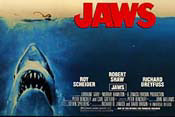 The "so-called" Renaissance of Hollywood was built upon perfecting some of the traditional film genres of Hollywood's successful past - with bigger, block-buster dimensions. Oftentimes, studios would invest heavily in only a handful of bankrolled films, hoping that one or two would succeed profitably. In the 70s, the once-powerful MGM Studios sold off many of its assets, abandoned the film-making business, and diversified into other areas (mostly hotels and casinos).
The "so-called" Renaissance of Hollywood was built upon perfecting some of the traditional film genres of Hollywood's successful past - with bigger, block-buster dimensions. Oftentimes, studios would invest heavily in only a handful of bankrolled films, hoping that one or two would succeed profitably. In the 70s, the once-powerful MGM Studios sold off many of its assets, abandoned the film-making business, and diversified into other areas (mostly hotels and casinos).
Much of the focus was on box-office receipts and the production of action- and youth-oriented, blockbuster films with dazzling special effects. But it was becoming increasingly more difficult to predict what would sell or become a hit. Hollywood's economic crises in the 1950s and 1960s, especially during the war against the lure of television, were somewhat eased with the emergence in the 70s of summer "blockbuster" movies or "event films" marketed to mass audiences, especially following the awesome success of two influential films:
- 27 year-old Steven Spielberg's Jaws (1975)
- 33 year-old George Lucas' Star Wars (1977)
Both films were masterfully-made, non-controversial genre films - and presaged what would be coming in the years and decades to come. Although the budget for Jaws grew from 4millionto4 million to 4millionto9 million during production, it became the highest grossing film in history - until Star Wars. Both Jaws and Star Wars were the first films to earn more than $100 million in rentals.
[The average ticket price for a film in 1971 was 1.65,andby1978costabouttwoandahalfdollarsinfirst−runtheatres.Second−runfilmtheatrescouldchargelessandoftendroppedtheiradmissionpriceto1.65, and by 1978 cost about two and a half dollars in first-run theatres. Second-run film theatres could charge less and often dropped their admission price to 1.65,andby1978costabouttwoandahalfdollarsinfirst−runtheatres.Second−runfilmtheatrescouldchargelessandoftendroppedtheiradmissionpriceto1.00. The average film budget by 1978 was about 5million−increasingdramaticallyto5 million - increasing dramatically to 5million−increasingdramaticallyto11 million by 1980 due to inflation and rising costs. Therefore, production of Hollywood films decreased precipitously in the late 70s, e.g., down to 354 releases in 1978 compared to the previous year's total of 560.]
New Markets for Hollywood's Products:
The emergence of ancillary markets for Hollywood's products emerged during this decade:
 cable television - the first pay/premium television channel, Home Box Office (HBO), was founded in 1972; in 1975, HBO demonstrated the popularity of its programming and became the first in the television industry to use satellites for regular transmission of programming, with its "Thrilla in Manila" boxing match between Muhammad Ali and Joe Frazier
cable television - the first pay/premium television channel, Home Box Office (HBO), was founded in 1972; in 1975, HBO demonstrated the popularity of its programming and became the first in the television industry to use satellites for regular transmission of programming, with its "Thrilla in Manila" boxing match between Muhammad Ali and Joe Frazier- the success of HBO in the mid-'70s spurred the growth of cable TV. Soon after, new satellite-delivered basic and premium cable TV networks were successfully competing against the major TV networks in the late '70s and early '80s, including movie channels such as Viacom's Showtime (1976, with satellite broadcast in 1978), Warner Amex's The Movie Channel (1979), Time/HBO'sCinemax (1980), The Disney Channel (1983) and American Movie Classics (AMC) (1984).
- to maximize profits from weekend audiences, the industry decided to move major film openings from mid-week to Fridays, in 1973
- pay cable television was able to allow profanity and sex beyond what could be offered on commercial network television - outrageous comedian George Carlin's first comedy special was aired on HBO as On Location: George Carlin at USC (1977) with cautionary disclaimers about the use of strong language; it was the first of many HBO comedy concert broadcasts
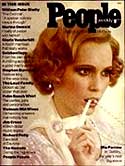 multi-plex theaters - the proliferation of multi-screen chain theaters in suburban areas, replacing big movie palaces, meant that more movies could be shown to smaller audiences; the world's largest cineplex (with 18 theaters) opened in Toronto in 1979
multi-plex theaters - the proliferation of multi-screen chain theaters in suburban areas, replacing big movie palaces, meant that more movies could be shown to smaller audiences; the world's largest cineplex (with 18 theaters) opened in Toronto in 1979- publicity/celebrity magazines - after Life Magazine discontinued its weekly publications in 1972, People Magazine - first published as a weekly magazine in March of 1974 (with Mia Farrow on its first cover), took over the role of celebrity watching and film promotion for the industry
- Hollywood realized that it could increase its profits by advertising its new releases on television - first shown to be successful with the massive TV marketing campaign (of $700,000 for three nights of nationwide prime-time TV ads on all the networks) for Jaws (1975). Universal called it "the biggest national TV spot campaign in industry history." The film was also booked into almost 500 theatres for its opening weekend - a record!
- Gone With the Wind (1939) first aired on network TV in 1976 and drew a huge audience over two nights - about 34 million people - the largest ever film audience to watch a feature film on television
The Home Video Revolution: A Short History
- earlier in the previous decade, Ampex in 1963 offered the first consumer version of a videotape recorder at an exorbitant price of $30,000; other iterations would follow, such as Sony's introduction of the videocassette recorder (VCR) in 1969, and the introduction of the U-Matic in 1972
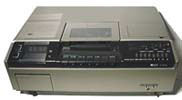 in 1972, the AVCO CartriVision System was the first videocassette recorder to have pre-recorded tapes of popular movies (from Columbia Pictures) for sale and rental -- three years before Sony's Betamax system emerged into the market. However, the company went out of business a year later
in 1972, the AVCO CartriVision System was the first videocassette recorder to have pre-recorded tapes of popular movies (from Columbia Pictures) for sale and rental -- three years before Sony's Betamax system emerged into the market. However, the company went out of business a year later- the appearance of Sony's Betamax (the first home VCR or videocassette recorder) in 1975 offered a cheaper sales price of $2,000 and recording time of up to one hour; this led to a boom in sales - it was a technically-superior format when compared to the VHS System that was marketed by JVC and Matsushita beginning in 1976
- Consumers had a choice of two playing/recording formats in the late ’70s: VHS (Video Home System) or Sony’s Betamax.
- in 1976, Paramount became the first to authorize the release of its film library onto Betamax videocassettes. In 1977, 20th Century Fox would follow suit, and begin releasing its films on videotape
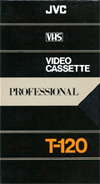 in 1977, RCA introduced the first VCRs in the United States based on JVC's VHS system, capable of recording up to four hours on 1/2" magnetic videocassette tape (with a flip-up cover at its front), or 2 hours with better quality
in 1977, RCA introduced the first VCRs in the United States based on JVC's VHS system, capable of recording up to four hours on 1/2" magnetic videocassette tape (with a flip-up cover at its front), or 2 hours with better quality- by the late 70s, Sony's market share in sales of Betamax VCRs was below that of sales of VHS machines; consumers chose the VHS' longer videocassette tape time and larger tape size, over Sony's smaller and shorter tape time (of 1 hour) [Note: by 1987, about 90 percent of the $5.25 billion market of VCRs sold in the United States were based on the VHS format.]
- video sales - the first films on videotape were released by the Magnetic Video Corporation (a company founded in 1968 by Andre Blay in Detroit, Michigan, the first video distribution company) - it licensed fifty films for release from 20th Century Fox for $300,000 in October, 1977; it began to license, market and distribute half-inch videotape cassettes (both Betamax and VHS) to consumers; it was the first company to sell pre-recorded videos; M*A*S*H (1970) was Magnetic's most popular title
- video rentals - in 1977, George Atkinson of Los Angeles began to advertise the rental of 50 Magnetic Video titles of his own collection in the Los Angeles Times, and launched the first video rental store, Video Station, on Wilshire Boulevard, renting videos for $10/day; within 5 years, he franchised more than 400 Video Station stores across the country
- in 1978, Philips introduced the video laser disc (aka laserdisc and LD) -- the first optical disc storage media for the consumer market; Pioneer began selling home LaserDisc players in 1980
- eventually, the laserdisc systems would be replaced by the DVD ("digital versatile disc") format in 1997 and within a decade entirely replaced VHS systems; the last stand-alone JVC VHS VCR was produced in October of 2008.
Initially considered a threat to movies because consumers could tape off-the-air, the technology was re-evaluated once studios discovered lucrative sales and rentals from taped versions of their commercially-released movies. This was a new income stream that actually promoted and stimulated business. VHS video players, laser disc players and the release of films on videocassette tapes and discs multiplied as prices plummeted, creating a new industry and adding substantial revenue and profits for the movie studios. All of the major Hollywood studios had their own video divisions (e.g., Warner Bros. formed Warner Home Video in the late '70s), and by the late '80s in the U.S., income from video rentals was double that of the theatrical box office. Also, independent film-makers and producers could now market their films more effectively by distributing tapes and discs for viewing.
It was clear that the advent of new ways of viewing films: (via subscription cable TV, via videocassette or laserdisc) meant that film audiences could now watch, record, or rent films that previously were difficult to see. A new wave of collecting massive libraries of films developed amongst consumers who intently followed each week's new releases, and interest in film-watching burgeoned. However, one major negative side-effect or downside to home-viewing was that the concept of a 'collective audience' attending a film together in a theater was being supplanted by the isolated viewer. Theater attendance would begin to drastically decline in the next decade due to the home video invasion.
Pornography and Videotape Revenues:
One film-related industry that side-benefited from the development of the VCR (and VHS) was the pornography industry - no longer would adult-movie viewers have to visit seedy X-rated film theatres to view porn films, and this resulted in sky-rocketing profits from the sales and rentals of X-rated videotapes.
[Note: It has been widely claimed, although strongly disputed, that the VHS system won the marketing war against Sony's Betamax system, partially due to Sony's prohibition of pornographic X-rated content on its tapes. In fact, porn was available on Betamax, but it was true that there was a lot more porn produced on VHS than Betamax. However, it was also true that porn revenues - although large - made up only a small fraction of the total revenue of annual video revenues - including both rentals and sales.
Changes from Traditional Hollywood Movie Studios:
The established Hollywood movie studios (except for Universal and Walt Disney's Buena Vista) no longer directly controlled production. Although studios still dominated film distribution, other areas including production, filming and financing (in whole or part) were increasingly in the hands of independent studios, producers, and/or agents. A new generation of movie stars, including Jack Nicholson, Al Pacino, Robert De Niro, and Dustin Hoffman - were more skilled as "character actors," who could adapt and mold their screen images to play a number of diverse roles.
 In 1975, the Creative Artists Agency was founded by Michael Ovitz and two of his colleagues (formerly William Morris Agency agents) to represent actors and become a 'packager' of talent for film projects - resulting in the creation of competition among agents. And conglomerate investment corporations were buying up many of the studios' properties as part of their leisure entertainment divisions, with decisive power over decisions about the number of films and which hopefully-profitable projects to choose. All the elements of a film were brought together and packaged - the 'properties' of original screenplay, novel, or stage play were combined with proven box office stars, directors, and marketing strategies.
In 1975, the Creative Artists Agency was founded by Michael Ovitz and two of his colleagues (formerly William Morris Agency agents) to represent actors and become a 'packager' of talent for film projects - resulting in the creation of competition among agents. And conglomerate investment corporations were buying up many of the studios' properties as part of their leisure entertainment divisions, with decisive power over decisions about the number of films and which hopefully-profitable projects to choose. All the elements of a film were brought together and packaged - the 'properties' of original screenplay, novel, or stage play were combined with proven box office stars, directors, and marketing strategies.
The cheaper cost of on-location filming (using Cinemobiles or film studios on wheels) encouraged more location shoots, or filming in rented production facilities. Faster film stock, lightweight cinematographic equipment, and the influence of the cinema vérité movement brought less formal styles to American productions. The functions of film makers were beginning to merge - there were actor-producers, director-producers, writer-producers, actor-writers, and more.
 For example, the decade's popular independent hit and Best Picture winner, director John Avildsen's sports film Rocky (1976) was the first (and best) in a long series of self-parody sequels that featured rags-to-riches actor and unknown scriptwriter Sylvester Stallone as underdog, inarticulate, Philadelphia boxer Rocky Balboa (inspired by boxer Chuck Wepner) in a "Cinderella" story. [As an up-and-coming star, Stallone had earlier co-scripted and starred as leather-jacketed Stanley Rosiello, opposite Henry Winkler as Butchey Weinstein, in the coming-of-age gang drama The Lords of Flatbush (1974).] The film's hero actually lost his bout after taking a brutal beating from Apollo Creed (inspired by Muhammad Ali), but he 'went the distance' and won girlfriend Adrian!
For example, the decade's popular independent hit and Best Picture winner, director John Avildsen's sports film Rocky (1976) was the first (and best) in a long series of self-parody sequels that featured rags-to-riches actor and unknown scriptwriter Sylvester Stallone as underdog, inarticulate, Philadelphia boxer Rocky Balboa (inspired by boxer Chuck Wepner) in a "Cinderella" story. [As an up-and-coming star, Stallone had earlier co-scripted and starred as leather-jacketed Stanley Rosiello, opposite Henry Winkler as Butchey Weinstein, in the coming-of-age gang drama The Lords of Flatbush (1974).] The film's hero actually lost his bout after taking a brutal beating from Apollo Creed (inspired by Muhammad Ali), but he 'went the distance' and won girlfriend Adrian!
The low-budget boxing film was one of the first major feature films to utilize the revolutionary "Steadicam" developed by inventor Garrett Brown. Bound for Glory (1976) marked its first use. It was a hand-held camera that produced fluid, unjerky motion shots - during the choreographed bouts and the scene in which the boxer jogged up the steps of the Philadelphia Museum of Art.
"Movie Brats" Mentored by 'King of the B's' Roger Corman:
With more power now in the hands of producers, directors, and actors, new directors emerged, many of whom had been specifically and formally trained in film-making courses/departments at universities such as UCLA, USC, and NYU, or trained in television. Roger Corman supported this new breed of youthful maverick directors, referred to by some as "Movie Brats" or "Geeks." The AIP studio (and Corman himself) was responsible for giving a start and apprenticeship experience to many upcoming filmmaking cineastes and actors, emphasizing low-budget film-making techniques and exploitative elements.
Corman hired the likes of Francis Ford Coppola, Martin Scorsese, Jonathan Demme, Joe Dante, Peter Bogdanovich, James Cameron, Jack Nicholson, Robert DeNiro, Paul Bartel, and Robert Towne. He gave many of these novices their first career-breaking employment opportunities, as actors, producers, directors, writers, members of film crews, etc. He encouraged them to produce personally-relevant and creative works of art, and new genre interpretations. This support revived the notion of auteurism (the belief that the director was most influential and responsible for creating a film's ultimate form, meaning and content).
| Some of the Prominent Movie Brats (or Geeks) of the 70s - a New Hollywood | |
|---|---|
| George Lucas (USC) | Robert Altman |
| John Carpenter (USC) | Francis Ford Coppola (UCLA) |
| Bob Rafelson | William Friedkin |
| Alan Pakula | Terrence Malick |
| Martin Scorsese (NYU) | Michael Ritchie |
| Brian De Palma (Columbia and Sarah Lawrence) | Woody Allen |
| Peter Bogdanovich | Paul Mazursky |
| Michael Cimino | Hal Ashby |
| Steven Spielberg | John Cassavetes |
| Paul Schrader (UCLA) | John Milius (USC) |
| Dennis Hopper | Mike Nichols |
| David Lynch | George Romero |
| Wes Craven | John Milius |
| James Cameron | Jonathan Demme |
| Joe Dante | Bruce Dern |
| Ron Howard | Gale Anne Hurd |
| John Sayles | Paul Bartel |
For instance, Peter Bogdanovich's directorial debut was for Targets (1968), made for AIP. And Francis Ford Coppola directed (and scripted) Corman's horror-thriller film Dementia 13 (1963) - it was Coppola's first mainstream picture. Jack Nicholson appeared in a number of early Corman movies, including his screen debut in The Cry Baby Killer (1958) and later a small role in The Little Shop of Horrors (1960) - about a carnivorous pet plant. One of Martin Scorsese's earliest-directed films (and his first commercially-conventional film) was Corman's Boxcar Bertha (1972) with Barbara Hershey and David Carradine as two Depression-era outlaw folk heroes. Writer/director Jonathan Demme's directorial debut was for Corman's Caged Heat (1974) -- a memorable women-in-prison film with lots of sex, nudity, action and violence. And Monte Hellman's two westerns Ride in the Whirlwind (1965) and The Shooting (1967) both starred Jack Nicholson (who also co-wrote and produced the first film).
Corman offered cinematic advice: use a fast-moving camera to provide speedy action, avoid cliches, add some minor social commentary, use visually-engaging screen compositions, sex (and nudity), tongue-in-cheek humor, and some sort of gimmick. Some of the new directors excelled with an audio-visual approach to filmmaking, where style, ear-splitting soundtracks, and action were sometimes more important in films than content.
The new American wave of film-makers were also influenced by unconventional works from the Italian Neo-realists, or the French New Wave artists, as stated earlier. Films made outside the traditional Hollywood mold from younger talents, with great works of character development, and sometimes with more violence and sex, were beginning to win critical praise and bring in tremendous revenues.
Old guard veterans were perplexed by the rapid change and lost some of their cutting edge or clout with a change in movie audience compositions. The once-provocative writer/director Billy Wilder could only come up with one hit in the 1960s decade (the popular odd-couple comedy The Fortune Cookie (1966)) while everything else fizzled (e.g., two romantic comedies including Irma La Douce (1963) with Shirley MacLaine as a Parisian prostitute, and the Dean Martin vehicle Kiss Me, Stupid (1964) - surprisingly 'condemned' by the Catholic League of Decency for its debauchery). And then in the 70s, Wilder had four unimpressive and mediocre films (the heavily-edited and recut The Private Life of Sherlock Holmes (1970), Avanti! (1972), The Front Page (1974), and Fedora (1978)). He ended his notable film-making career with the slight farce Buddy, Buddy (1981) - another effort with Jack Lemmon.
Another Golden Age veteran Vincente Minnelli also suffered in the new more youth-oriented decade with only two films in the 1970s before ending his directorial career: the musical On a Clear Day You Can See Forever (1970) starring Barbra Streisand, and the poorly-received drama A Matter of Time (1976) starring his own daughter - singer/actress Liza Minnelli.
Alfred Hitchcock:
As a footnote to the decade, director Alfred Hitchcock (without ever winning a Best Director Oscar) returned to England after his disappointing films Torn Curtain (1966) and Topaz (1969) to make his first British film in almost two decades - Frenzy (1972). His first Hollywood film had been Rebecca (1940), and his last film was in this decade - the lightweight thriller Family Plot (1976).
George Lucas
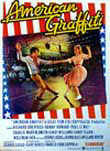
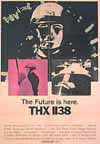 USC graduate George Lucas added his name to the list of new directors. His first film, produced by American Zoetrope and executive-produced by Francis Coppola, was a full-length version of a student science-fiction film he had made earlier - the nightmarish vision of a dehumanized future in THX 1138 (1971). The numerical moniker would appear as an 'in-joke' in later Lucas works: as the license plate of John Milner's car in American Graffiti (1973), as the number of the cell block holding "Chewbacca" in Star Wars (1977), in other films of the Star Wars series (except for Jedi), and in numerous other films (i.e., Swingers (1996), Sky Captain and the World of Tomorrow (2004)).
USC graduate George Lucas added his name to the list of new directors. His first film, produced by American Zoetrope and executive-produced by Francis Coppola, was a full-length version of a student science-fiction film he had made earlier - the nightmarish vision of a dehumanized future in THX 1138 (1971). The numerical moniker would appear as an 'in-joke' in later Lucas works: as the license plate of John Milner's car in American Graffiti (1973), as the number of the cell block holding "Chewbacca" in Star Wars (1977), in other films of the Star Wars series (except for Jedi), and in numerous other films (i.e., Swingers (1996), Sky Captain and the World of Tomorrow (2004)).
His second film that he co-wrote and directed, the low-budget American Graffiti (1973) was a warm-hearted, rites-of-passage film about a number of California teenagers (unknowns who became future stars including Harrison Ford, Cindy Williams, Mackenzie Phillips, and Richard Dreyfuss, among others) in the early 60s who pointlessly cruised down the main strip of their small town [Modesto, CA] in hot-rods one long summer night - accompanied by a non-stop soundtrack of rock 'n' roll hits (opening with Bill Haley and the Comets). The film's tagline or slogan encouraged nostalgia: "Where were you in '62?" Teenage archetypes included the hot-rod loving delinquent (Paul Le Mat), the brainy student (Richard Dreyfuss), the stereotypical class president (Ron Howard), and the nerd (Charles Martin Smith).
In 1971, Lucas formed his own film company, Lucasfilm Ltd., in San Rafael, California that soon evolved into a number of specialized companies. Before his next major hit (Star Wars (1977)), Lucas organized Industrial Light and Magic (ILM), a post-production facility in Marin County to advance the area of special effects, modeling, sound design, computer-generated effects, and other ground-breaking techniques.
John Carpenter
 Little-known at first, John Carpenter directed the cult sci-fi film Dark Star (1974) - a feature length derivative of a student short made while he was studying film at USC. It was a parody of Stanley Kubrick's 2001: A Space Odyssey (1968). (Carpenter composed all of the musical scores for his films beginning with Dark Star.) He also directed the low-budget action thriller Assault on Precinct 13 (1976) (a modernized remake of Howard Hawks' Rio Bravo (1959)).
Little-known at first, John Carpenter directed the cult sci-fi film Dark Star (1974) - a feature length derivative of a student short made while he was studying film at USC. It was a parody of Stanley Kubrick's 2001: A Space Odyssey (1968). (Carpenter composed all of the musical scores for his films beginning with Dark Star.) He also directed the low-budget action thriller Assault on Precinct 13 (1976) (a modernized remake of Howard Hawks' Rio Bravo (1959)).
Carpenter became noticed, especially after his highly-successful, low-budget slasher film Halloween (1978) - it was his third feature film and the highest-grossing independent film made in the US up to that time. The hard-to-kill, masked, knife-wielding stalker Michael Myers suspensefully pursued a young, small-town babysitter Jamie Lee Curtis (later becoming the 'Queen of Horror') on Halloween night in a small mid-western town. In its wake, the profitable and stylishly-made film (often seen from the point of view of the killer), with its spooky recognizable soundtrack, spawned a mini-horror film boom, with many lesser 'psycho-slasher' or teen-scream films appearing into the 1980s.
Bob Rafelson
 Former writer, producer, and director in television (and noted for the Monkees television series), Bob Rafelson turned to movies in the late 60s. His feature debut was, predictably, the slapstick Monkees film Head (1968), co-written with Jack Nicholson. His second film (which brought Rafelson a Best Screenplay nomination) was one of the best of the 70s, Five Easy Pieces (1970), a fascinating, yet shattering 'road movie' story of an emotionally-alienated classical concert pianist named Bobby Dupea (Jack Nicholson shortly after his work in Easy Rider). He was displaced from his upper-class family and had fled to Southern California as a blue-collar oil-field rigger where he lived with a low-class waitress named Rayette (Karen Black) (who listened to Tammy Wynette music). His life was one of endless partying, promiscuous sex, playing cards and drinking. After years of exile, he returned to his ailing father on the family's isolated island estate in the Puget Sound area, where he again felt alienated and lost. In the film's final moments, he impulsively escaped again - abandoning Rayette at a gas station and hitching to places unknown in the north.
Former writer, producer, and director in television (and noted for the Monkees television series), Bob Rafelson turned to movies in the late 60s. His feature debut was, predictably, the slapstick Monkees film Head (1968), co-written with Jack Nicholson. His second film (which brought Rafelson a Best Screenplay nomination) was one of the best of the 70s, Five Easy Pieces (1970), a fascinating, yet shattering 'road movie' story of an emotionally-alienated classical concert pianist named Bobby Dupea (Jack Nicholson shortly after his work in Easy Rider). He was displaced from his upper-class family and had fled to Southern California as a blue-collar oil-field rigger where he lived with a low-class waitress named Rayette (Karen Black) (who listened to Tammy Wynette music). His life was one of endless partying, promiscuous sex, playing cards and drinking. After years of exile, he returned to his ailing father on the family's isolated island estate in the Puget Sound area, where he again felt alienated and lost. In the film's final moments, he impulsively escaped again - abandoning Rayette at a gas station and hitching to places unknown in the north.
In the 70s, Rafelson also directed a follow-up film The King of Marvin Gardens (1972) with Jack Nicholson, Bruce Dern and Ellen Burstyn, and the quirky Stay Hungry (1976) with Sally Field and Jeff Bridges (and a very early performance by Arnold Schwarzenegger). His next notable film was the sexy remake The Postman Always Rings Twice (1981) with Jack Nicholson and Jessica Lange.
Alan Pakula
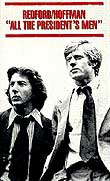 Another former film producer Alan Pakula directed Liza Minnelli in her second film role in The Sterile Cuckoo (1969) a poignant, oddball comedy/drama about a neurotic and eccentric college student named Pookie Adams.
Another former film producer Alan Pakula directed Liza Minnelli in her second film role in The Sterile Cuckoo (1969) a poignant, oddball comedy/drama about a neurotic and eccentric college student named Pookie Adams.
Pakula's best films in the 70s were Klute (1971) - a superb detective thriller about the stalking of a tough New York hooker (Jane Fonda won an Academy Award for her performance), and the compelling political melodrama All the President's Men (1976) about two young, non-conformist, Pulitzer Prize-winning Washington Post news reporters Woodward and Bernstein (Robert Redford and Dustin Hoffman) who bucked the system and investigated the 1972 Watergate break-in, burglary, and subsequent cover-up. Pakula also directed the believable and gripping political conspiracy thriller The Parallax View (1974) - casting Warren Beatty as a journalist investigating a presidential candidate's assassination. Burt Reynolds starred with Jill Clayburgh in Alan Pakula's popular adult romantic comedy Starting Over (1979).

Film History of the 1970s
Part 1, Part 2, Part 3, Part 4, Part 5, Part 6


